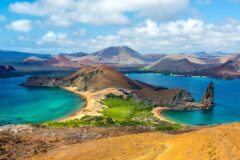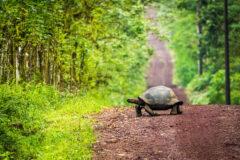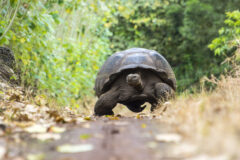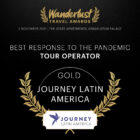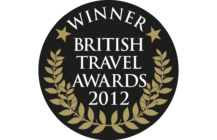Places to visit in Galapagos Islands

Baltra
Baltra is a small island which hosts the islands' principal airport and offers public transport to Puerto Ayora by bus and ferry as well as private transfers for visitors.
Explore more
Bartolome (Bartholomew)
A walk to the summit of this small island reveals a pitted moonscape; one of the most photographed panoramas in the archipelago. There are views of the island's twisted lava formations and the sea-sculpted Pinnacle Rock, smothered with Galápagos penguins and marine turtles.
Explore more
Espanola (Hood)
There’s a huge variety of birds and reptiles, nesting or on the cliffs. Some species (eg. The waved albatross) aren’t seen elsewhere. There’s a spectacular blowhole: spray shoots 30m high.
Explore more
Fernandina (Narborough)
An active volcanic island with frequent eruptions. Its steep flanks, streaked with successive lava flows, are arid; marine iguanas gather in their thousands. There’s an interesting shore-line trail.
Explore more
Floreana (Charles)
Pirates and whalers dropped anchor here. Visit Post Office Bay, where a barrel served as mailbox to send letters home and snorkel around Devil’s Crown, a part-submerged crater.
Explore more
Genovesa (Tower)
Inside the sunken caldera birds are visible in their thousands: you can hike along the rim. Snorkel with hammerhead sharks or cruise along the cliff ledges to rocky steps named after HRH Prince Philip.
Explore more
Isabela (Albemarle)
The island has five active volcanoes linked by arid, twisted lava flows. Its cliffs and bays are ideal for exploration by boat and for hikes, and snorkelling is top-notch here.
Explore more
North Seymour
Covered with boulders and low bushy vegetation. You can watch the courting mating and nesting rituals here of frigate birds and boobies, stroll on the beach or snorkel.
Explore more
Plaza Islands
There’s a cactus forest populated by land iguanas and vegetation which changes colour from green in the rainy season to orange in the dry. Go hiking, birdwatching, swimming and snorkelling.
Explore more
Rabida (Jervis)
This small island has a red coral sand beach and a saltwater flamingo lagoon. It’s studded with small volcanic craters along sharp slopes and cliffs. There’s a bird-flecked trail leading inland.
Explore more
San Cristobal Island (Chatham)
The Interpretation Centre, where you learn about the history of the islands, is in Puerto Baquerizo Moreno, the capital. Isla Lobos is a dramatic outcrop living up to its name "sea lion island”.
Explore more
Santa Cruz Island (Indefatigable)
Over 12,000 residents live in Puerto Ayora with services for visitors who board cruise vessels or stay in hotels and in the highlands There are lava tunnels to explore and giant tortoises to spot roaming wild in the mountains.
Explore more
Santa Fe (Barrington)
An exquisite island with a turquoise lagoon. Some of the giant cacti here grow 10m high. Some rocks are 4 million years old. A couple of trails lead past sea-lion colonies inland.
Explore more
Santiago Island (James)
A favourite for pirates and whalers. There are outstanding opportunities for bird-spotting. Stroll around the rock pools or climb Sugar Loaf volcano for views from its summit.
Explore more
Sombrero Chino (Chinese Hat)
The distinctive shape of this tiny volcanic cone island gave birth to its name. There's a trail around the shore where you can walk among marine iguanas.
Explore morePapagaio
Your edit for Latin American inspiration
Our exciting range of articles on Latin America explore everything from iconic destinations and lesser-known cultural gems to delicious traditional recipes. You’ll also find exclusive travel tips, first-hand client reviews and the chance to get your personal questions answered by our travel experts.
View Extraordinary Inspiration